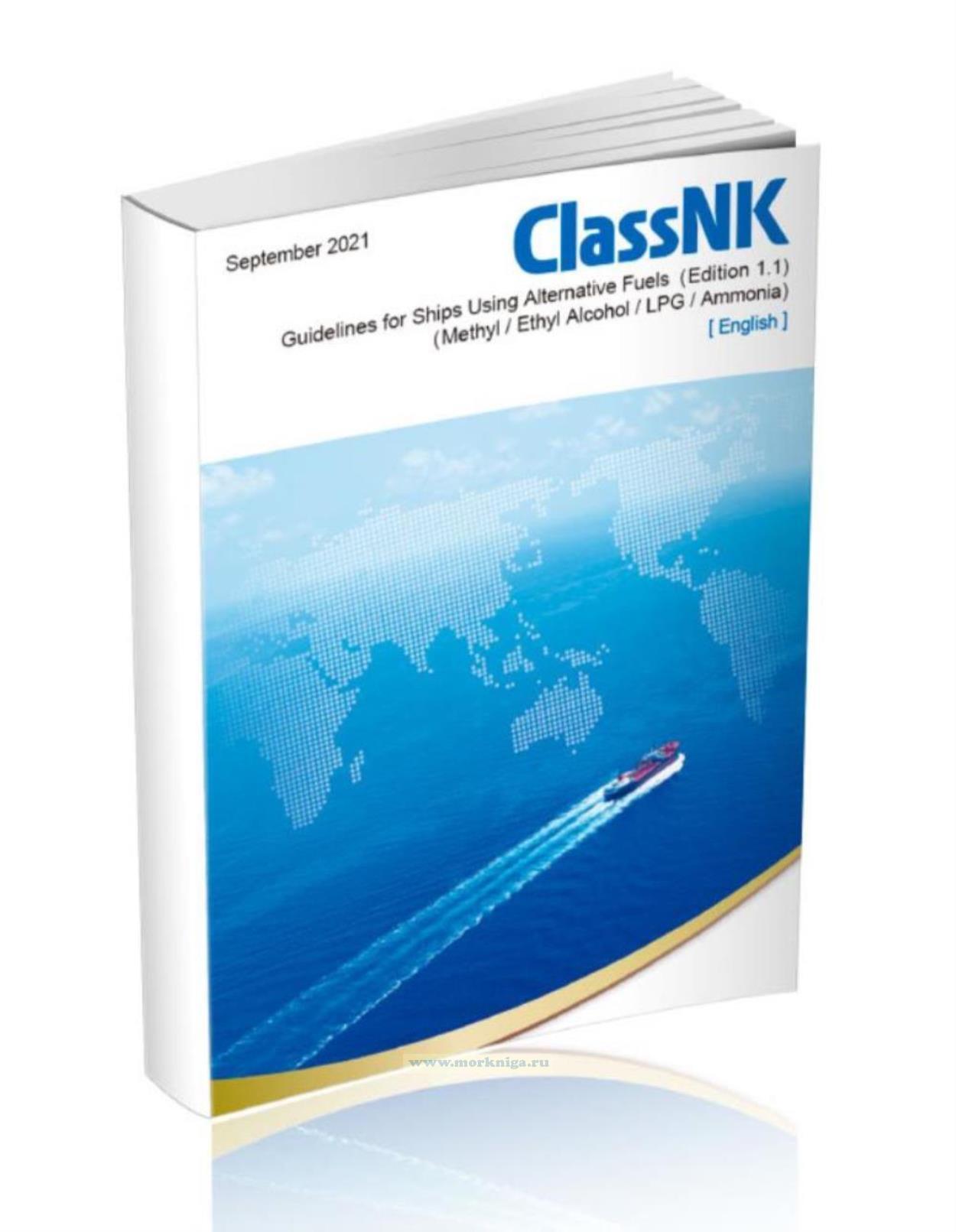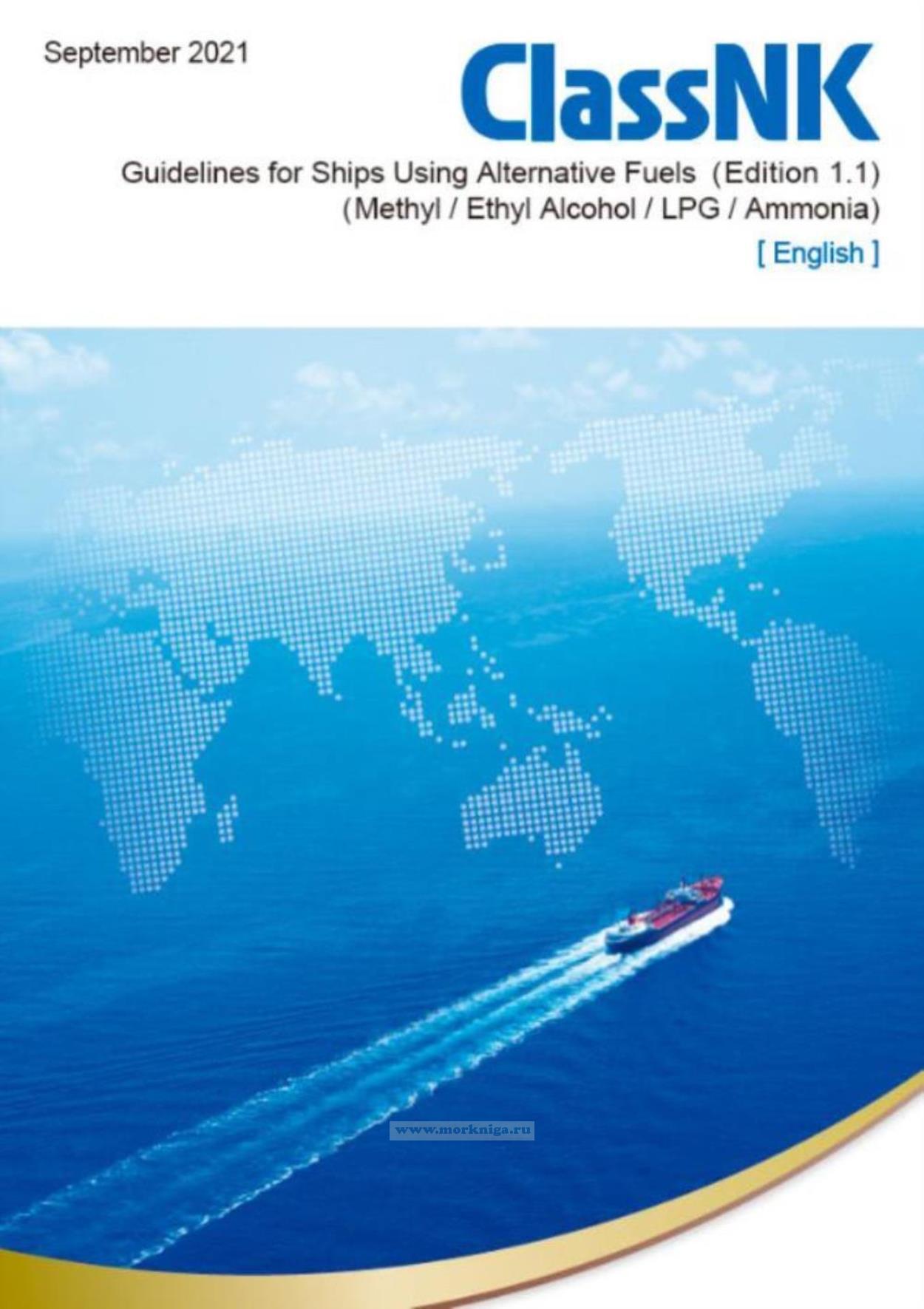Guidelines for Ships Using Alternative Fuels (Methyl/Ethyl Alcohol/LPG/Ammonia)/–†—Г–Ї–Њ–≤–Њ–і—Б—В–≤–Њ –і–ї—П —Б—Г–і–Њ–≤, –Є—Б–њ–Њ–ї—М–Ј—Г—О—Й–Є—Е –∞–ї—М—В–µ—А–љ–∞—В–Є–≤–љ—Л–µ –≤–Є–і—Л —В–Њ–њ–ї–Є–≤–∞ (–Љ–µ—В–Є–ї–Њ–≤—Л–є/—Н—В–Є–ї–Њ–≤—Л–є —Б–њ–Є—А—В/–°–Э–У/–∞–Љ–Љ–Є–∞–Ї)
–Ъ–љ–Є–≥–∞ –љ–∞ –∞–љ–≥–ї–Є–є—Б–Ї–Њ–Љ —П–Ј—Л–Ї–µ.
Part A. These guidelines provide provisions for the arrangement, installation, control and monitoring of machinery, equipment and systems using methyl/ethyl alcohol as fuel to minimize the risk to the ship, its crew and the environment, having regard to the nature of the fuels involved.
Part B. These guidelines provide provisions for the arrangement, installation, control and monitoring of machinery, equipment and systems using LPG as fuel to minimize the risk to the ship, its crew and the environment, having regard to the nature of the fuels involved.
Part C. The Guidelines for Ships Using Ammonia as Fuel (hereinafter referred to as ¬Ђthe Guidelines¬ї) makes reference to requirements specified in SOLAS, the IGC Code and the IGF Code with a view to minimizing the risks to ships, seafarers and the environment in consideration of the particular characteristics of ammonias well as the standards for the equipment (including associated control and monitoring systems) installed on board ships using ammonia as fuel, which have been independently established by the Society up until now. The Guidelines is intended to be helpful with respect to the implementation of alternative designs as wellas the submission of requests for approval to Flag State Administrations related to the use of ammonia as fuel. Although this version of the Guidelines was primarily developed based on currently available information, the Society intends to regularly review and update it as deemed necessary so as to fully incorporate the knowledge obtained from future operational data and research and development results to ensure that the information contained therein does not become outdated or otherwise inaccurate.
Annex. This annex applies to ships classed with the Nippon Kaiji Kyokai (hereinafter referred to as ¬Ђthe Society¬ї), that take measures beforehand in preparation for possible future conversion to the becoming a ship using alternative fuel for which an application to affix relevant notation to the shipвАЩs classification characters is made. The term ¬Ђmeasures¬ї in this context means that the ship has either a concept design for future conversion, or both a concept design and detailed design for partial facilities related to alternative fuel use and associated installations. Hereinafter, such measures are referred to as ¬ЂAlternative Fuel Ready¬ї, and this also applies to ships using alternative fuels that are designed for the use of other alternative fuels in the future.
Contents
Chapter 1 Preamble
Chapter 2 General
2.1 Application
2.2 Definitions
2.3 Alternative design
Chapter 3 Goal and Functional Requirements
3.1 Goal
3.2 Functional requirements
Chapter 4 General Requirements
4.1 Goal
4.2 Risk assessment
4.3 Limitation of explosion consequences
Chapter 5 Ship Design and Arrangement
5.1 Goal
5.2 Functional requirements
5.3 General requirements
5.4 Independent fuel tanks
5.5 Portable tanks
5.6 Machinery space
5.7 Location and protection of fuel piping
5.8 Fuel preparation spaces design
5.9 Bilge systems
5.10 Drip trays
5.11 Arrangement of entrances and other openings in enclosed spaces
5.12 Airlocks
Chapter 6 Fuel Containment System
6.1 Goal
6.2 Functional requirements
6.3 Fuel tanks venting and gas freeing system
6.4 Inerting and atmospheric control within the fuel storage system
6.5 Inert gas availability on board
Chapter 7 Material and General Pipe Design
7.1 Goal
7.2 Functional requirements
7.3 General pipe design
7.4 Piping fabrication and joining details
7.5 Materials
Chapter 8 Bunkering
8.1 Goal
8.2 Functional requirements
8.3 Bunkering station
8.3.1 General requirements
8.3.2 Ships bunker hoses
8.4 Manifold
8.5 Bunkering system
Chapter 9 Fuel Supply to Consumers
9.1 Goal
9.2 Functional requirements
9.3 General requirements
9.4 Fuel distribution
9.5 Redundancy of fuel supply
9.6 Safety functions of the fuel supply system
9.7 Fuel preparation spaces and pumps
Chapter 10 Power Generation Including Propulsion and Other Energy Converters
10.1 Goal
10.2 Functional requirements
10.3 General requirements
10.4 Dual-fuel engines
10.5 Single fuel engines
Chapter 11 Fire Safety
11.1 Goal
11.2 Functional requirements
11.3 General requirements
11.4 Fire protection
11.5 Fire main
11.6 Firefighting
11.7 Extinguishing of engine-room and fuel preparation space
Chapter 12 Explosion Prevention and Area Classification
12.1 Goal
12.2 Functional requirements
12.3 General requirements
12.4 Area classification
12.5 Hazardous area zones
12.5.1 Hazardous area zone 0
12.5.2 Hazardous area zone 1
12.5.3 Hazardous area zone 2
Chapter 13 Ventilation
13.1 Goal
13.2 Functional requirements
13.3 General
13.4 Fuel preparation spaces
13.5 Bunkering station
13.6 Ducts and double wall pipes
Chapter 14 Electrical Installations
14.1 Goal
14.2 Functional requirements
14.3 General
Chapter 15 Control, Monitoring and Safety Systems
15.1 Goal
15.2 Functional requirements
15.3 General requirements
15.4 Bunkering and fuel tank pipe monitoring
15.4.1 Level indicators for fuel tanks
15.4.2 Overflow control
15.5 Bunkering control
15.6 Engine monitoring
15.7 Gas detection
15.8 Fire detection
15.9 Ventilation
15.10 Safety functions of fuel supply systems
Chapter 16 Drills and Emergency Exercises
16.1 Goal
Chapter 17 Operation
17.1 Goal
17.2 Functional requirements
17.3 Requirements for maintenance
17.4 Requirements for bunkering operations
17.4.1 Responsibilities
17.4.2 Overview of control, automation and safety systems
17.4.3 Pre-bunkering verification
17.4.4 Ship bunkering source communications
17.4.5 Electrical bonding

